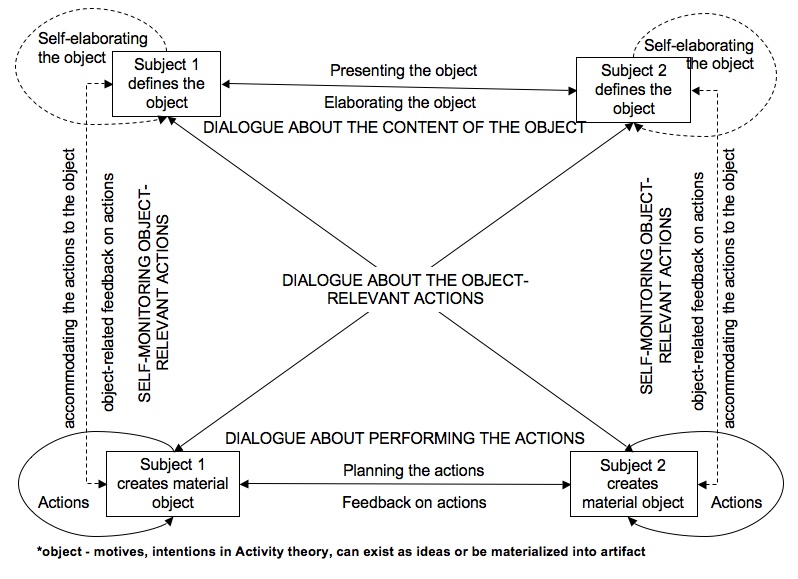“The emphasis on finding and describing “knowledge structures” that are somewhere “inside” the individual encourages us to overlook the fact that human cognition is always situated in a complex sociocultural world and cannot be unaffected by it.” (Hutchins, 1995, p. xiii)
Over the 20th century, many have explored the question “how can the cognitive processes we normally associate with an individual mind be implemented in a group of individuals?” All the discussions converged towards the idea that “the cognitive properties of a group can differ from the cognitive properties of the members of the group” (Hutchins, 2000, p. 4).
Ed Hutchins has spent his “academic carreer trying to understand human cognition in social, cultural and material context”. He “believe[s] that cultural practices are a key component of human cognition”. In the mid 80s, he and his colleagues at the University of California, San Diago, developed the Distributed Cognitive theory–a psychological theory–where he claimed “that cognition is better understood as a distributed phenomenon” (Rogers, 1997, p. 1). Cognition in the Wild (MIT Press, 1995) is Hutchins’ first attempt at a coherent statement of the principles of distributed cognition.
According to Rogers (1997), “distributed cognition is a hybrid approach to studying all aspects of cognition, from a cognitive, social and organisational perspective” (p. 1). The approach considers the “distributed nature of cognitive phenomena across individuals, artefacts and internal and external representations in terms of a common language of ‘representational states’ and ‘media'” (p. 2).
Therefore, using insights from sociology, cognitive science, and the psychology of Vygotsky, the theory emphasizes the social aspects of cognition.
- Cognitive concepts applied “to the interactions among a number of human actors and technological devices for a given activity”. The representations that information is held in and transformed across.
- Intersubjectivity, organisational learning and the distribution of labor are part concepts utilised to account for the socially-distributed cognitive phenomenon. The process by which representations are co-ordinated with each other.
Hutchins’s views of cognition contrasted with traditional views in which the focus was on localised phenomenon best explained as information processing at the level of the individual. Within the distributed cognitive activities, technological artefacts and other tools and representations are utilized. Hence, the distributed cognition compared to other approaches has its own properties.
- “A general assumption of the distributed cognition approach is that cognitive systems consisting of more than one individual have cognitive properties that differ from those individuals that participate in those systems”.
- “The knowledge possessed by members of the cognitive system is both highly variable and redundant. Individuals working together on a collaborative task are likely to possess different kinds of knowledge and so will engage in interactions that will allow them to pool the various resources to accomplish their tasks”.
- “Much knowledge is shared by the individuals, which enables them to adopt various communicative practices (e.g. not having to spell out every time they meet someone what they know about a practice, procedure or state of affairs)”.
- “The distribution of access to information in the cognitive system. Sharing access and knowledge enables the coordination of expectations to emerge which in turn form the basis of coordinated action”.
The following graphic illustrates the interelation between subjects and artefacts in action in order for the distributed cognition to happen.
Figure A (http://tihane.wordpress.com/2007/02/)
Metaphors and examples:
The following are some examples to explain when Distributed Cognition is seen.
- A ship steers into harbour. It needs coordination of representational states that involves several members of the navigation team whom are plotting bearings of the ship while getting it into the harbour at regular intervals of time. This task involved some complex coordination of people and artefacts. As mentionned by Hutchins (1995), it “provides a structured experience for the team members enabling more generally, individual learning of procedures and the cultural practices of the navy”.
- A complex arithmetic problem involves distributed cognition if done in collaboration with a friend to clarify it. Paper might be utilized to write partial answers to be remembered. In this case, distributed cognition is seen by doing the problem in collaboration and by performing some arithmetic procedures in the people’s heads, but also by using a tool to extend one’s memory. So it is “distributed between people, and a person and an object”.
- A cockpit flight crew and flight’s collaborators on the ground working on a flight. Cooperation and coodination of actions among personel, including pilots and crew members, sensors and machinery in a plane and on the ground is viewed as a system of activity where indispensable shared cognition emerges.
Stop and Reflect:
Take a moment to think about the following questions.
- Provide an example where Distributed Cognition is used in the classroom? Be specific.
- What do you think about Distributed Cognition and its connection to today’s workplace? Explain your answer according to a specific sociocultural context.
- Do you believe in collaboration within people to evolve better understandings and learning of the object? Justify your answer.
Now, if you are interested about research, watch this video on Distributed Cognition as a Theoretical Framework for Information Visualization.
“Humans create their cognitive powers in part by creating the environments in which they exercise those powers” (Hutchins, 2000, p. 9)


Sadly i could not see tge video the link is down